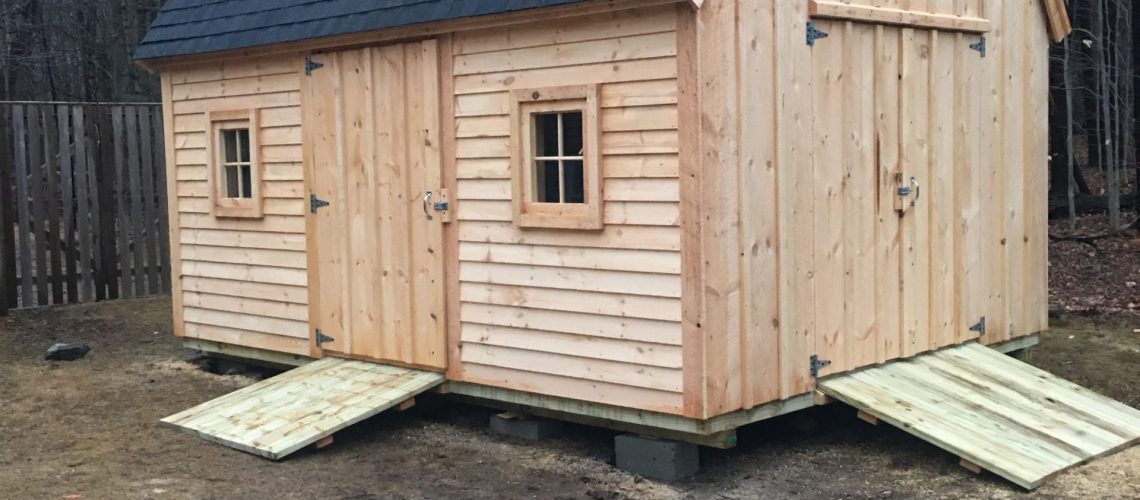8 Types of Shed Foundation to Give Your Shed a Solid Base
There isn’t such a thing as a ‘one size fits all’ shed foundation. There is such a variation in size of shed, usage of sheds and also variation in the ground itself that you will need to make some sort of judgement based on your situation. I have put together a guide to the main types of shed foundations you might consider on this page. To find out more about each type just click on the links to the types that interest you to get more in-depth information.
Before we delve into the different types of shed foundation lets just go a bit deeper into the design of shed foundations. How do shed foundations work? What can you expect from a shed foundation? How deep should a shed foundation be? What if you choose the wrong type of foundation?
How do shed foundations work?
All foundations work in a similar way by distributing the weight of a shed over a larger area so that they do not exceed the bearing capacity of the ground that supports them. To explain this in simple terms, imagine you are walking in the snow in your normal boots, with each footstep you sink up to your knees (or further) depending on how deep the snow is. However, if you wear snow shoes your weight is distributed over a larger area and you can walk more easily without sinking in so deep. Shed foundations work in a similar way by spreading the weight of the shed over an area so that the timbers don’t sink into the mud.
What can you expect from a shed foundation?
Shed foundations aren’t as stable as a house foundation. They generally don’t need to be as stable as it doesn’t matter so much if the shed moves a little bit. House foundations are dug deep and designed to keep movements to a minimum. This is for several reasons including:
- Drainage connections to the house would be affected by movement
- Cracks in a house wall are a lot more noticeable and concerning
- Houses often have brittle internal finishes so cracks are more noticeable
- Houses are larger than sheds and so if one part moves a different amount to another then some form of crack will occur
If a shed does move and tilt to one side for some reason, because they are small and relatively light it is quite easy to straighten them up and make them level again.
How deep should shed foundations be?
As we discussed above house foundations are designed for minimal movement and so are dug relatively deep. Dependent on where you live and the type of soil underlying your house a typical absolute minimum depth of house foundation is about 400mm. The reason for this is so that the underside of the foundation is beneath the ‘frost zone’. As the ground gets cold and freezes in the winter the soil expands and can lift structures where the underside of the foundation is above this zone. The frost zone varies dependent on how far North you live the colder the area the deeper the frost zone. For most places in the UK the minimum foundation depth for houses is 600mm.
However for sheds, foundations don’t need to be anywhere near this depth. Because it doesn’t matter so much if sheds move (see above) shed foundations can be relatively shallow. Even if you live in frost susceptible zones.
Generally the ground in an area has better bearing capacity the deeper you dig and will also be more stable.
So what are the main types of shed foundation?
Foundations for small sheds
When it comes to the smallest sheds foundations are often not needed and the existing landscaping has more than sufficient capacity to support the shed. For the two sheds in the following example the ground was sufficiently level and firm for them to be built directly on the hardstanding. The adjustable shed feet enabled the shed to be built on the sloping brick paving in one case and on small concrete paving slabs in the other.
Small shed using adjustable plastic shed jacks
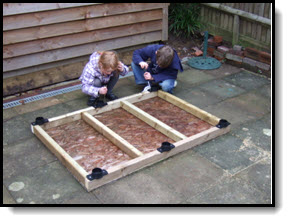
Adjustable shed foundation – using plastic jacks
Use adjustable metal screw jacks on larger sheds
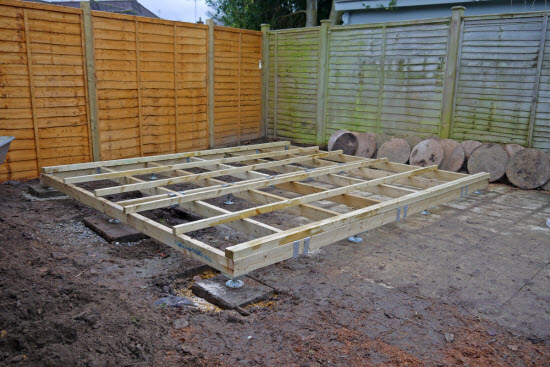
Adjustable shed foundation – metal jacks
Cheapest/easiest shed foundations
Cost and ease of installation are often important for shed builders. These three foundation types are all relatively easy to install with minimal excavation. One of the most important factors for all shed foundations is that the base is level. This makes construction of the shed to the required accuracy much easier. The foundations are listed below in order of ease of construction, mainly because of the weight of materials:
-
- Plastic shed foundations – These come in two main types. Those that are designed specifically for supporting sheds and then ones that are designed for landscaping purposes.
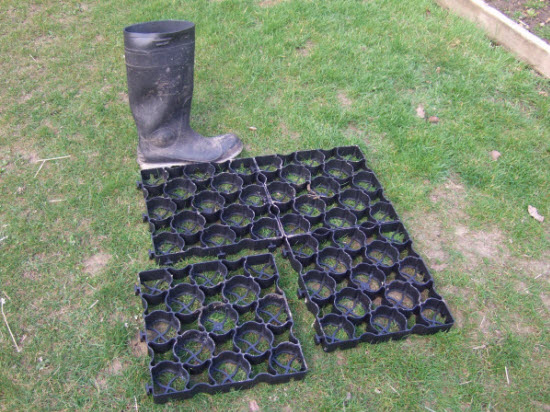 Interlocking plastic foundation grids
Interlocking plastic foundation grids
- Plastic shed foundations – These come in two main types. Those that are designed specifically for supporting sheds and then ones that are designed for landscaping purposes.
-
- Timber bears – Timber bearers are a good foundation method. As the foundation is made of long straight elements it can be easier than other types to construct a good level support.
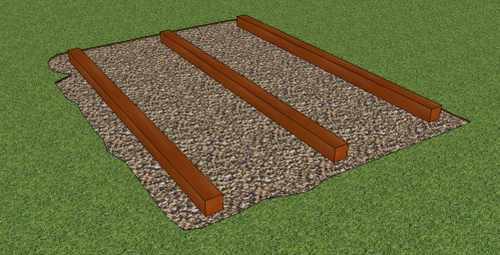 Building a shed foundation with timber bearers
Building a shed foundation with timber bearers
- Timber bears – Timber bearers are a good foundation method. As the foundation is made of long straight elements it can be easier than other types to construct a good level support.
- Concrete paving slabs – Concrete paving slabs are cheap and durable. They act to spread the load over the full footprint of the shed.
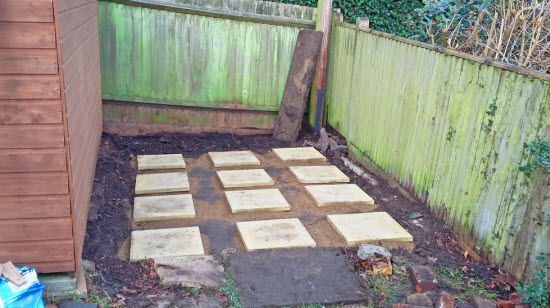 Shed foundation using concrete paving slabs
Shed foundation using concrete paving slabs
More involved/durable shed foundation types
Concrete shed base – The concrete slab foundation is perhaps the most robust type of foundation. Often known as a ‘raft’ this type of foundation can include reinforcement or just be plain concrete.
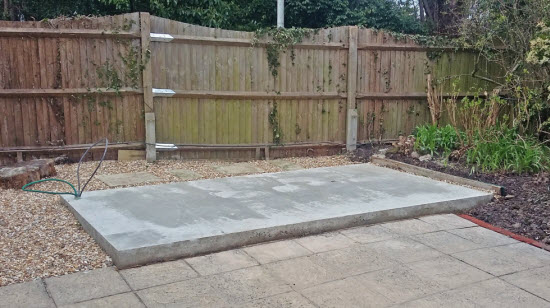 Concrete shed foundation
Concrete shed foundation
What if your shed site is sloping?
There is no doubt that building a shed on sloping ground is a bit more challenging than a perfectly flat site. But building a shed on a slope is easily manageable.
 Which option is best for you?
Which option is best for you?
-
- The most common option for building a shed on a slope is the pier foundation. It is also useful on flat ground.
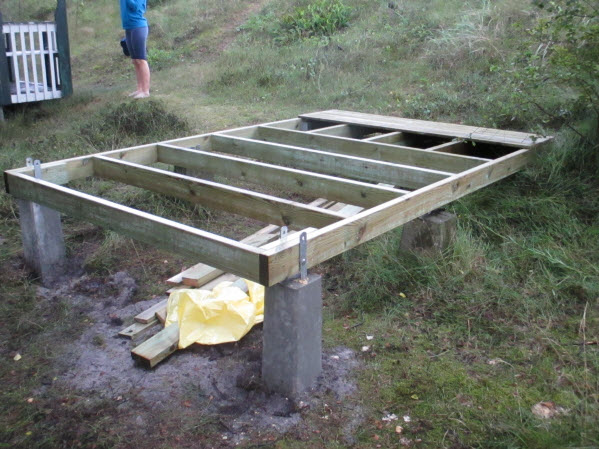 Shed pier foundation
Shed pier foundation
Shed foundation summary
This article has summarized the the main types of shed foundation and then links to more in depth articles which show you how to build each type.
The main types of shed foundation are:
-
- Adjustable plastic base
- Adjustable metal base
- Plastic
- Timber
- Concrete paving slabs
- Poured concrete base
- Pier foundation
- Retaining wall type base
